2016 KIA Soul EV voltage
[x] Cancel search: voltagePage 406 of 524
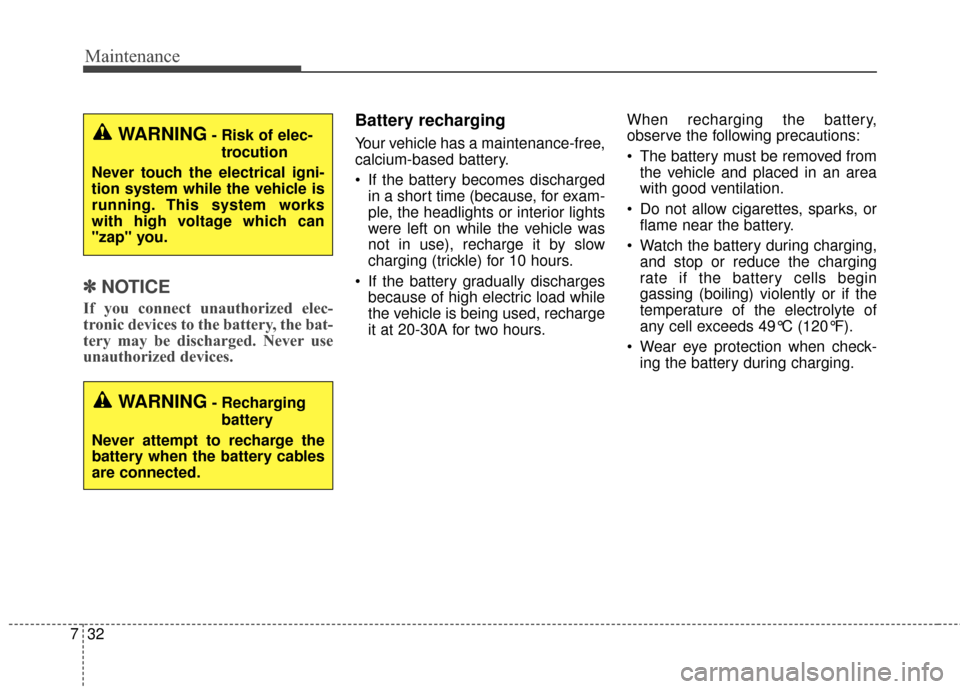
Maintenance
32
7
✽ ✽
NOTICE
If you connect unauthorized elec-
tronic devices to the battery, the bat-
tery may be discharged. Never use
unauthorized devices.
Battery recharging
Your vehicle has a maintenance-free,
calcium-based battery.
If the battery becomes discharged
in a short time (because, for exam-
ple, the headlights or interior lights
were left on while the vehicle was
not in use), recharge it by slow
charging (trickle) for 10 hours.
If the battery gradually discharges because of high electric load while
the vehicle is being used, recharge
it at 20-30A for two hours. When recharging the battery,
observe the following precautions:
The battery must be removed from
the vehicle and placed in an area
with good ventilation.
Do not allow cigarettes, sparks, or flame near the battery.
Watch the battery during charging, and stop or reduce the charging
rate if the battery cells begin
gassing (boiling) violently or if the
temperature of the electrolyte of
any cell exceeds 49°C (120°F).
Wear eye protection when check- ing the battery during charging.WARNING- Risk of elec-
trocution
Never touch the electrical igni-
tion system while the vehicle is
running. This system works
with high voltage which can
"zap" you.
WARNING- Recharging battery
Never attempt to recharge the
battery when the battery cables
are connected.
Page 451 of 524
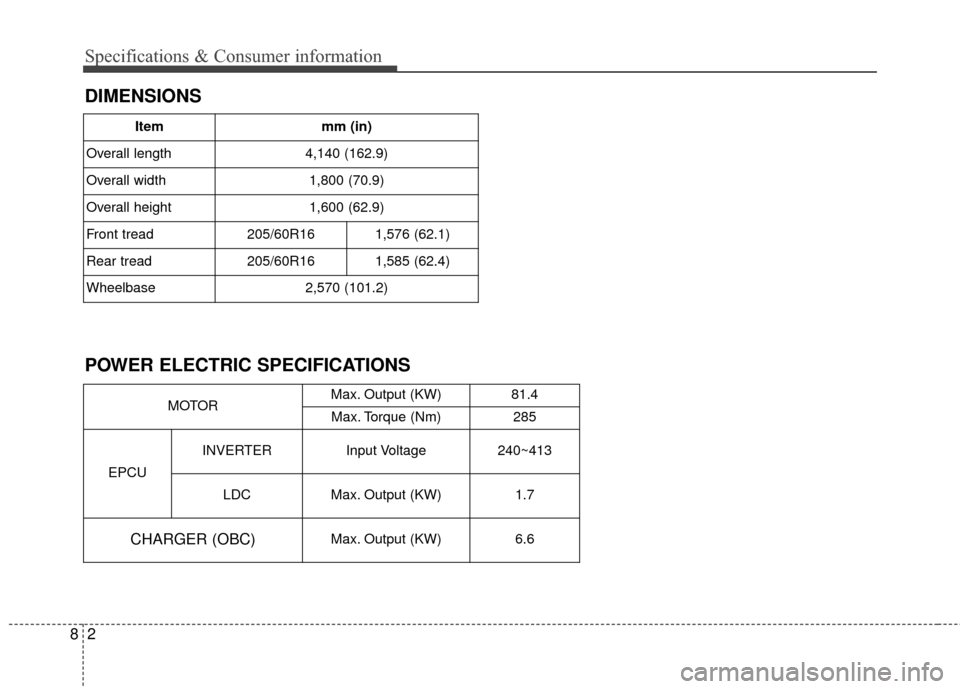
Specifications & Consumer information
28
DIMENSIONS
POWER ELECTRIC SPECIFICATIONS
Itemmm (in)
Overall length
4,140 (162.9)
Overall width
1,800 (70.9)
Overall height
1,600 (62.9)
Front tread
205/60R161,576 (62.1)
Rear tread
205/60R161,585 (62.4)
Wheelbase
2,570 (101.2)
MOTOR Max. Output (KW) 81.4
Max. Torque (Nm) 285
EPCU INVERTER
Input Voltage 240~413
LDC Max. Output (KW) 1.7
CHARGER (OBC)Max. Output (KW)6.6
Page 466 of 524

Electric Vehicle Guide
❈This is an electric vehicle guide to assist drivers with
understanding their vehicle.
Refer to the following content for electric vehicle details
and precautions
Review of Electric Vehicle ........................................................2
Main Components of Electric Vehicle.......................................4
High voltage battery .................................................................5
EV Mode ........................................................................\
..........7
■ Available Range .................................................................7■ Near by stations .................................................................8■ Energy Information. ............................................................8■ ECO Driving .......................................................................9\
■ Setting Charging Times .....................................................9■ Setting Climate Times ......................................................10■ EV Setting ........................................................................\
11
Charge Types for Electric Vehicle...........................................12
Charge Indicator Lamp for Electric Vehicle ............................14
Reserved Charging ................................................................15
Reserved Climate Control. .....................................................17
Precautions for Charging Electric Vehicle ..............................18
Charging Electric Vehicle (Normal Charge) ...........................21
■ How to Connect Normal Charger .....................................21■ Unlock Charging Door in Emergency ...............................24■ Emergency Release of the Charging connector
lock system .......................................................................2\
5
■ Checking Charging Status................................................25■ How to Disconnect Normal Charger ................................26
Charging Electric Vehicle (Quick Charge) ..............................27
■ How to Connect Quick Charger .......................................27■ Unlock Charging Door in Emergency ...............................30■ Checking Charging Status................................................30■ How to Disconnect Quick Charger ...................................31
Charging Electric Vehicle (Trickle Charge) .............................33
■ How to Connect Portable Charging Cable .......................33■ Unlock Charging Door in Emergency ...............................37■ Emergency Release of the Charging connector
lock system .......................................................................3\
8
■ Checking Charging Status................................................38■ Charging Status Indicator Lamp for Portable Charging
Cable ........................................................................\
........39
■ How to Disconnect Portable Charging Cable ..................40■ Precautions for Portable Charging Cable .........................42
Driving Electric Vehicle ...........................................................43
■ How to Start the Vehicle ...................................................43■ How to Stop the Vehicle ...................................................44■ Pedestrian Warning System .............................................45■ Active ECO system ..........................................................45■ Range ........................................................................\
.......46■ Tips for Improving Distance to Empty ..............................47■ Motor Operation Gauge....................................................47■ State of charge (SOC) gauge for high voltage battery.....48■ Warning Message on LCD Display (related to charge)....49■ Warning Lamp and Indicator Lamp
(related to electric vehicle) ...............................................52
Safety Precautions for Electric Vehicle...................................55
■ Service Plug .....................................................................58
Environmental Friendliness Mark ...........................................58
Page 467 of 524
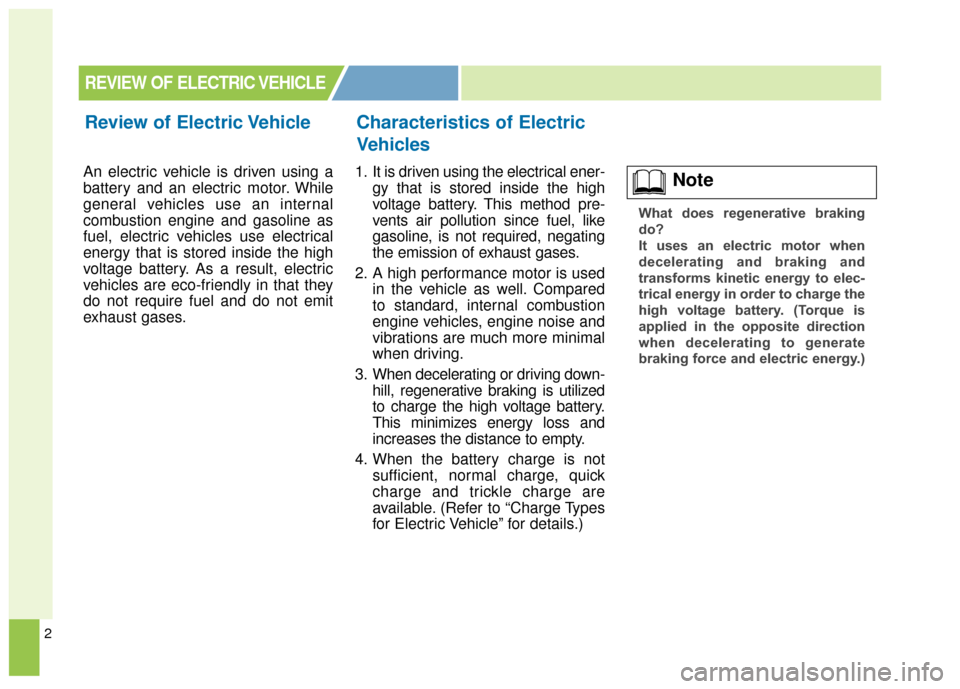
2
An electric vehicle is driven using a
battery and an electric motor. While
general vehicles use an internal
combustion engine and gasoline as
fuel, electric vehicles use electrical
energy that is stored inside the high
voltage battery. As a result, electric
vehicles are eco-friendly in that they
do not require fuel and do not emit
exhaust gases.1. It is driven using the electrical ener-
gy that is stored inside the high
voltage battery. This method pre-
vents air pollution since fuel, like
gasoline, is not required, negating
the emission of exhaust gases.
2. A high performance motor is used in the vehicle as well. Compared
to standard, internal combustion
engine vehicles, engine noise and
vibrations are much more minimal
when driving.
3. When decelerating or driving down- hill, regenerative braking is utilized
to charge the high voltage battery.
This minimizes energy loss and
increases the distance to empty.
4. When the battery charge is not sufficient, normal charge, quick
charge and trickle charge are
available. (Refer to “Charge Types
for Electric Vehicle” for details.)
REVIEW OF ELECTRIC VEHICLE
Review of Electric Vehicle Characteristics of Electric
Vehicles
What does regenerative braking
do?
It uses an electric motor when
decelerating and braking and
transforms kinetic energy to elec-
trical energy in order to charge the
high voltage battery. (Torque is
applied in the opposite direction
when decelerating to generate
braking force and electric energy.)
Note
Page 468 of 524
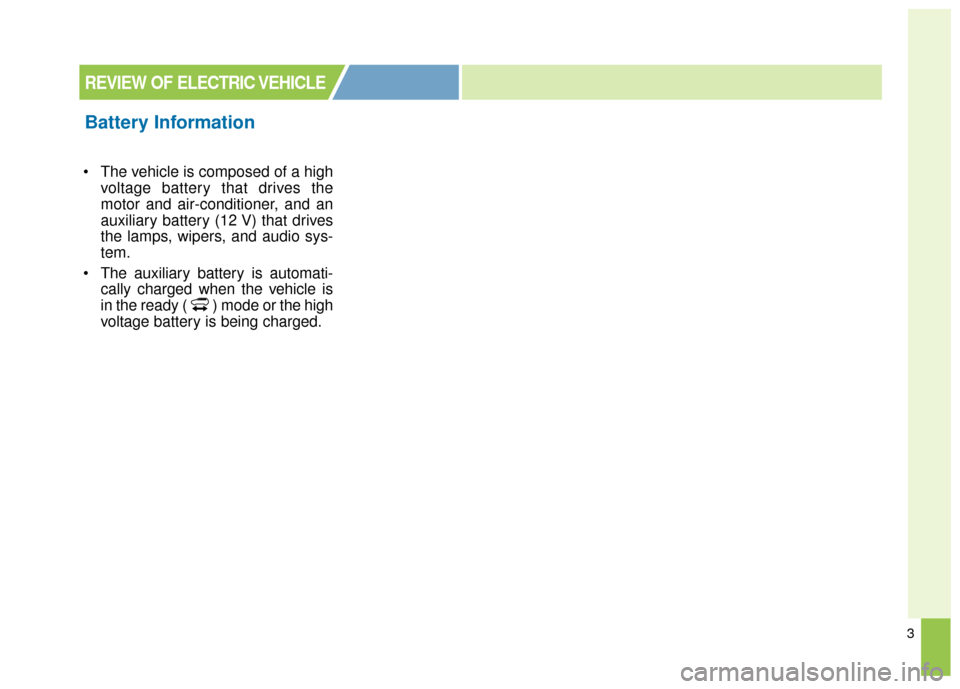
3
The vehicle is composed of a highvoltage battery that drives the
motor and air-conditioner, and an
auxiliary battery (12 V) that drives
the lamps, wipers, and audio sys-
tem.
The auxiliary battery is automati- cally charged when the vehicle is
in the ready ( ) mode or the high
voltage battery is being charged.
REVIEW OF ELECTRIC VEHICLE
Battery Information
Page 469 of 524
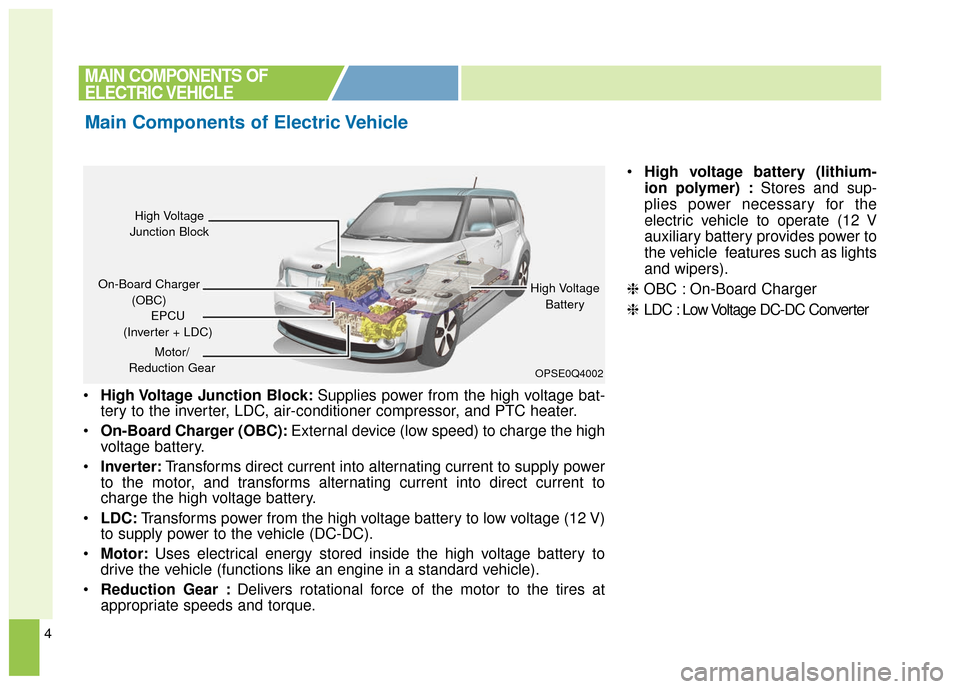
4
High Voltage Junction Block: Supplies power from the high voltage bat-
tery to the inverter, LDC, air-conditioner compressor, and PTC heater.
On-Board Charger (OBC): External device (low speed) to charge the high
voltage battery.
Inverter: Transforms direct current into alternating current to supply power
to the motor, and transforms alternating current into direct current to
charge the high voltage battery.
LDC: Transforms power from the high voltage battery to low voltage (12 V)
to supply power to the vehicle (DC-DC).
Motor: Uses electrical energy stored inside the high voltage battery to
drive the vehicle (functions like an engine in a standard vehicle).
Reduction Gear : Delivers rotational force of the motor to the tires at
appropriate speeds and torque.
High voltage battery (lithium-
ion polymer) : Stores and sup-
plies power necessary for the
electric vehicle to operate (12 V
auxiliary battery provides power to
the vehicle features such as lights
and wipers).
❈ OBC : On-Board Charger
❈ LDC : Low Voltage DC-DC Converter
MAIN COMPONENTS OF
ELECTRIC VEHICLE
Main Components of Electric Vehicle
OPSE0Q4002
High Voltage
Junction Block
On-Board Charger (OBC) High Voltage
Battery
EPCU
(Inverter + LDC)
Motor/
Reduction Gear
Page 470 of 524
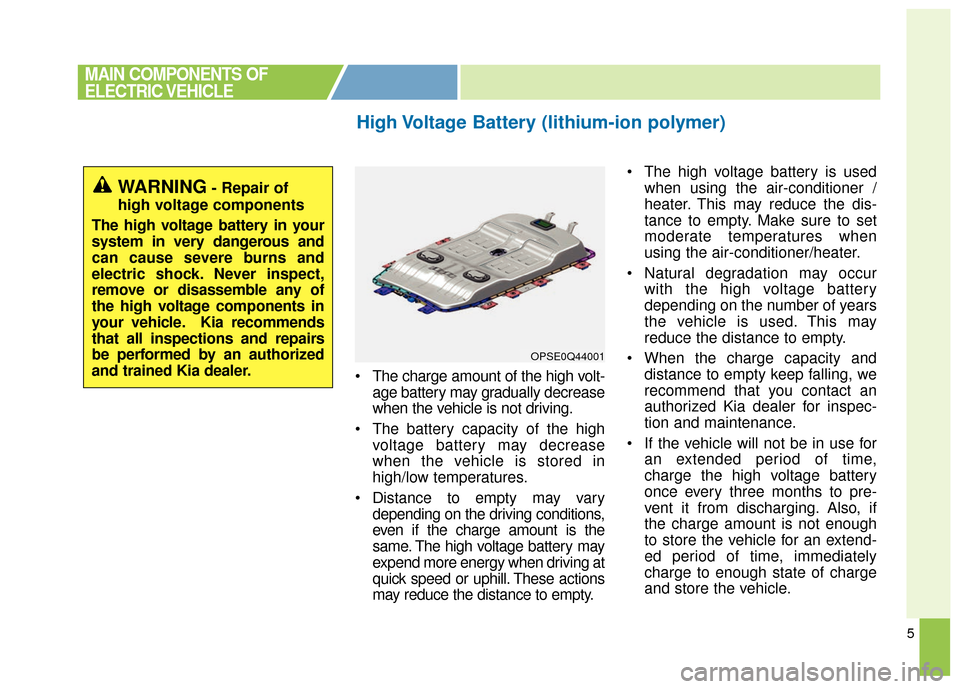
5
The charge amount of the high volt-age battery may gradually decrease
when the vehicle is not driving.
The battery capacity of the high voltage battery may decrease
when the vehicle is stored in
high/low temperatures.
Distance to empty may vary depending on the driving conditions,
even if the charge amount is the
same. The high voltage battery may
expend more energy when driving at
quick speed or uphill. These actions
may reduce the distance to empty. The high voltage battery is used
when using the air-conditioner /
heater. This may reduce the dis-
tance to empty. Make sure to set
moderate temperatures when
using the air-conditioner/heater.
Natural degradation may occur with the high voltage battery
depending on the number of years
the vehicle is used. This may
reduce the distance to empty.
When the charge capacity and distance to empty keep falling, we
recommend that you contact an
authorized Kia dealer for inspec-
tion and maintenance.
If the vehicle will not be in use for an extended period of time,
charge the high voltage battery
once every three months to pre-
vent it from discharging. Also, if
the charge amount is not enough
to store the vehicle for an extend-
ed period of time, immediately
charge to enough state of charge
and store the vehicle.
High Voltage Battery (lithium-ion polymer)
MAIN COMPONENTS OF
ELECTRIC VEHICLE
OPSE0Q44001
WARNING- Repair of
high voltage components
The high voltage battery in your
system in very dangerous and
can cause severe burns and
electric shock. Never inspect,
remove or disassemble any of
the high voltage components in
your vehicle. Kia recommends
that all inspections and repairs
be performed by an authorized
and trained Kia dealer.
Page 471 of 524
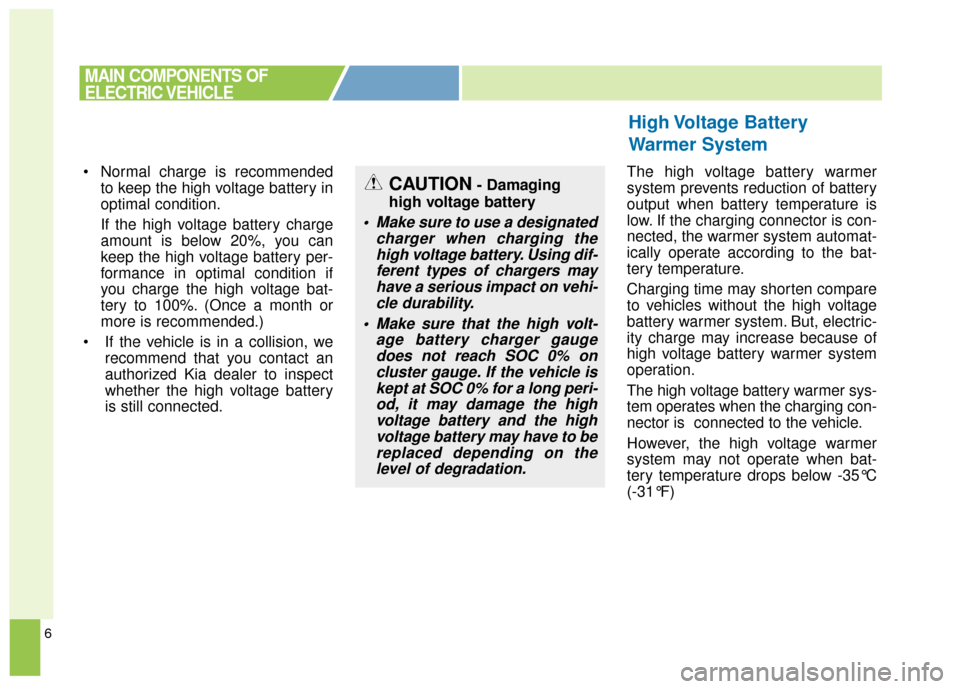
6
Normal charge is recommendedto keep the high voltage battery in
optimal condition.
If the high voltage battery charge
amount is below 20%, you can
keep the high voltage battery per-
formance in optimal condition if
you charge the high voltage bat-
tery to 100%. (Once a month or
more is recommended.)
If the vehicle is in a collision, we recommend that you contact an
authorized Kia dealer to inspect
whether the high voltage battery
is still connected. The high voltage battery warmer
system prevents reduction of battery
output when battery temperature is
low. If the charging connector is con-
nected, the warmer system automat-
ically operate according to the bat-
tery temperature.
Charging time may shorten compare
to vehicles without the high voltage
battery warmer system. But, electric-
ity charge may increase because of
high voltage battery warmer system
operation.
The high voltage battery warmer sys-
tem operates when the charging con-
nector is connected to the vehicle.
However, the high voltage warmer
system may not operate when bat-
tery temperature drops below -35°C
(-31°F)
High Voltage Battery
Warmer System
MAIN COMPONENTS OF
ELECTRIC VEHICLE
CAUTION- Damaging
high voltage battery
• Make sure to use a designated charger when charging thehigh voltage battery. Using dif-ferent types of chargers mayhave a serious impact on vehi-cle durability.
Make sure that the high volt- age battery charger gaugedoes not reach SOC 0% oncluster gauge. If the vehicle iskept at SOC 0% for a long peri-od, it may damage the highvoltage battery and the highvoltage battery may have to bereplaced depending on thelevel of degradation.